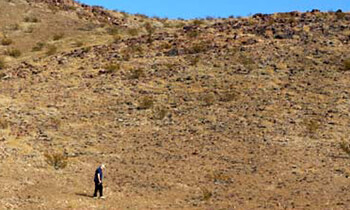Canyon Treefrogs
Hyla arenicolor
by Damian Fagan
I descend the trail to Sipapu Natural Bridge in Natural Bridges National Monument in pre-dawn darkness. Though the trail is closed, I am working as a contract biologist, so I am granted access to the area to do my work. I have two bird survey routes in the canyon, and today’s survey is between the Sipapu and Kachina bridges.

As I hike the trail between these bridges, I hear the far-off bleating of sheep, or something that sounds like bleating sheep.
I round a bend in the canyon; the bleating stops. I stop. The bleating resumes. I continue. Eventually the trail crosses the boulder-strewn creek and I catch the trailing segment of sound coming from one of the nearby pools. On closer inspection, I do not find sheep. But I do find frogs, canyon treefrogs.
Though the frogs are hard to see because of their skin color, which closely resembles the sandstone wall, they are easy to locate as they plop into the shallow pools. Their aquatic escapes are brief, as the frogs haul themselves out soon afterwards and perch on a small rock or cling to the canyon wall.

Behavior
The males call together to the female segment of the population. They are advertising their availability to mate, and from the sounds of things, there are quite a few bachelors in the neighborhood.
When the males chorus, vocal sacs located below their chins inflate like a dusky, opaque balloon. The single sac helps the call to resonate and project beyond this pool. This “community chorus” draws the females to the pools, though how each selects her mate, I don’t know.

In his Beeplants and Whiptails, Larry Hyslop describes an encounter with treefrogs in Zion National Park, “Across the pond, the now familiar call of a male frog is a sound much too loud for such a small frog. It is nothing humans would call beautiful although I assume it sounds good to a female frog.” Others describe this call as “the bleating of a sheep with a cold” or “sounds like brrurt-brrurt-brrurt, like a rivet gun coming from inside a tin can.”
What these frogs lack in size, they make up in voice. Adults are 1" to 2" inches long from snout to vent, and they have an ash-gray to dark brown skin. There are spots or darker blotches on the upperside of the plump body, while the underside is white or cream colored. The undersides of the thighs are yellow or orangish. Adults also have a light spot with a dark edge just beneath the eye.
Habitat
These frogs occur throughout the Southwest, in southern Utah, northern and eastern Arizona, western New Mexico, northern Oaxaca, and parts of Texas and Colorado. They inhabit a wide elevation gradient, from sea level to 9800 feet. As amphibians they are tied to riparian or rock-pool habitats, where the females will lay their eggs. In canyon creeks such as Natural Bridges’ White Canyon, the eggs may be laid singularly, but in the pothole or tinaja habitats these eggs may be clumped in a jelly envelope. A female may lay several hundred eggs. The eggs’ protective coverings may attach to submerged leaves, twigs or rocks, or just float in the pool.
Life Cycle
The breeding season runs from March to August, depending upon temperature and elevation. Generally, evening water temperatures should be above 55° Fahrenheit. The warmer the water, the faster the eggs develop. Males may be heard in Saguaro National Monument in March or Natural Bridges National Monument in May or June.
The tadpoles mature into adults in about 70 days. The eggs are vulnerable to predation by fish, aquatic invertebrates, small mammal predators and salamander larvae. An estimated two percent of the eggs will mature into adults, and of this amount, around ten percent will survive the first year. Though the larvae feed on algae and detritus, the adults prefer a diet of ants, beetles, spiders, centipedes, winged insects and other invertebrates.
Description
The treefrog’s scientific name is Hyla arenicolor. Hyla means “tree,” although this species spends little time in trees or shrubs. Arenicolor means, “sand color or tone” and refers to the skin color. The remarkable thing about the frog’s skin is that it changes color like a chameleon to match the surrounding substrate.
This cryptic coloration enables the frogs to blend in with their surroundings. Their best defense is concealment, for they lack poisonous glands, teeth or sharp claws. During the day they hide among rocks or bank overhangs along the creek. Though they do climb vegetation, they are observed more often on the ground, on rocks, or in the water.

Shaped like suction cups, the toe pads have tiny divisions that spread apart and enable the frogs to gain a better grip on surfaces. The last two bones of each toe have extra cartilage segments between them, enabling the frogs to swivel their toe and place it flat against a surface. Their long legs also allow them to make sizeable leaps.
Treefrogs, like other frogs, have a unique respiratory system. They use their lungs for breathing but also utilize a cutaneous respiration system to supply oxygen to their body. Air is drawn in through the moist skin via blood vessels that lie just below the skin surface. This enables the frog to stay submerged while avoiding predators.
Though the frogs had quieted down long before I ascended out of the canyon, I was pleased to hear their choruses in the early morning. Even if they sounded like a flock of rivet-popping, runny-nosed sheep.
![]()
Red-spotted Toads
Woodhouse's Toad
Share this page on Facebook:
The Desert Environment
The North American Deserts
Desert Geological Terms







